For crystal-clear focus stacks, you’ll need a microscope camera with at least 100x magnification and 1080p resolution. Top options include the Nikon D5200 with T-adapter compatibility, Olympus TG-6 with dedicated microscope mode, and TAGARNO TREND offering 330x magnification. Consider camera sensor type—CMOS for faster capture or CCD for superior low-light performance—and verify compatibility with stacking software like Helicon Focus. Your choice between USB, HDMI, or wireless connections affects your workflow efficiency and image quality.
Understanding Focus Stacking in Microscope Photography
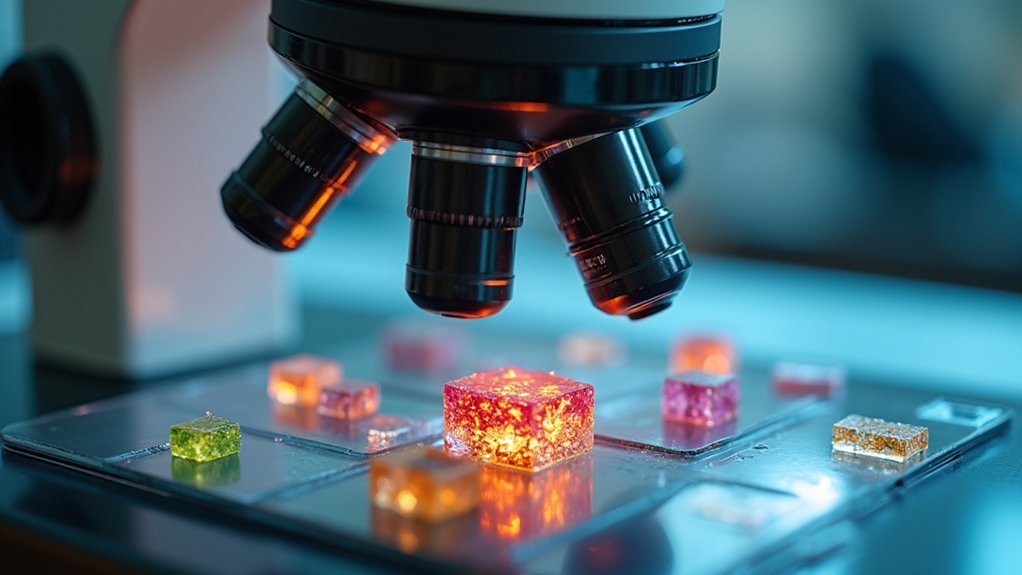
The challenge of microscopy lies in its inherently shallow depth of field. At high magnifications, only a thin slice of your specimen appears sharp, while everything else blurs. This is where focus stacking becomes invaluable for capturing quality photos that reveal every detail.
This technique involves taking 15-35 images at different focal depths and combining them using specialized software like Helicon Focus or Zerene Stacker. The result? A single, completely focused image that showcases your subject’s intricate features.
Success requires precise execution—stable camera positioning and careful focus increments guarantee each image captures distinct layers of your specimen.
Precision is non-negotiable—reliable camera mounting and methodical focusing create the layered detail that makes stacking truly effective.
Using high-quality Plan Achromatic lenses further enhances results by reducing chromatic aberrations and improving edge focus, ultimately delivering microscopic images with extraordinary clarity and detail.
Key Features to Consider When Selecting a Microscope Camera
When diving into microscope photography for focus stacking, choosing the right camera becomes critical to your success.
You’ll need a magnification range that exceeds 100x to capture the fine details required for effective stacking. Don’t compromise on sensor resolution—opt for at least 1080p to guarantee superior image quality in your final composites.
Frame rate matters greatly when capturing multiple focal planes quickly. Higher rates will provide smoother operation during the stacking process.
Pay close attention to lighting options, as proper illumination dramatically affects the clarity of each layer in your stack.
Finally, verify that your camera works seamlessly with specialized focus stacking software like Helicon Focus. This compatibility will save you countless hours during post-processing and yield more professional results.
Top High-Resolution Camera Options for Detailed Micro Imaging
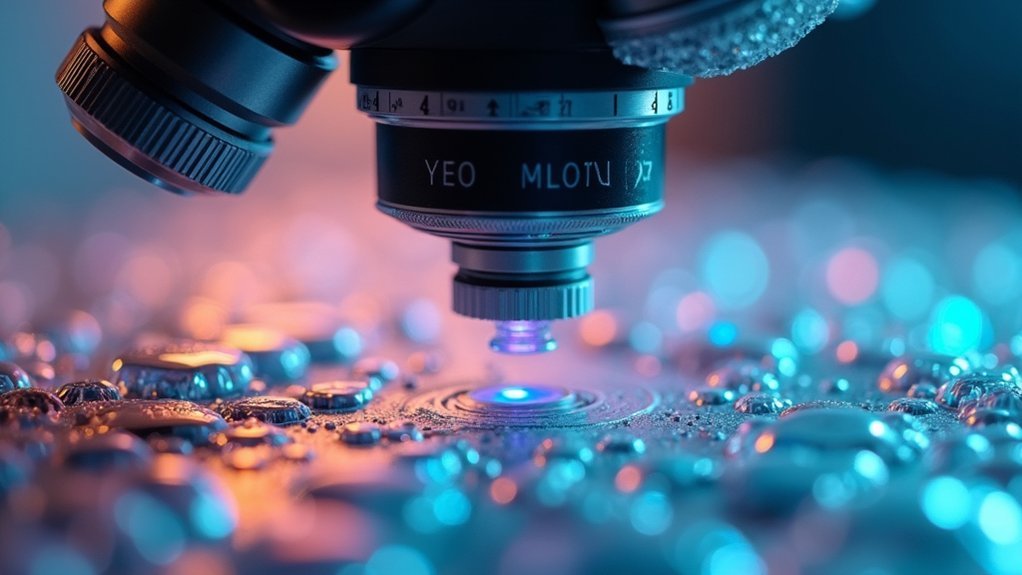
Because successful focus stacking hinges on capturing ultra-fine details, selecting a high-resolution camera becomes your most critical investment.
The right camera guarantees you’ll capture high quality images across varying focus distances, creating stunning composite results.
Exceptional focus stacking demands pristine detail capture at every depth point to ensure seamless final composites.
- The Nikon D5200 pairs excellently with microscopes when using appropriate T-adapters for photomicrography.
- Olympus TG-6 offers dedicated microscope mode, perfect for beginners seeking impressive magnification.
- TAGARNO TREND delivers exceptional 330x magnification with 1080p resolution for professional-grade clarity.
- Pairing your camera with Helicon Remote software automates the focus stacking workflow.
- Consider investing in Helicon Focus Pro for hardware acceleration when processing large image stacks.
When evaluating options, prioritize cameras that maintain clarity throughout diverse focus distances while offering seamless integration with your existing microscope setup.
CMOS vs. CCD Sensors: Which Performs Better for Focus Stacking?
Selecting the right sensor technology dramatically impacts your focus stacking results, yet many microscopists overlook this essential decision. When choosing between CMOS and CCD sensors, you’ll need to balance your specific imaging requirements.
| Feature | CMOS | CCD |
|---|---|---|
| Speed | Faster readout, ideal for multiple focus layers | Slower, but often better for single images |
| Quality | Modern versions rival CCDs | Superior in low-light conditions |
| Power | Lower consumption | Higher consumption |
CMOS sensors excel when you need speed and efficiency, capturing multiple images quickly for thorough focus stacks. However, if you’re working with intricate crystal structures in low light, CCD’s superior dynamic range might deliver better quality. Today’s advanced CMOS sensors have narrowed the performance gap, offering competitive image quality while maintaining their speed advantage.
Essential Software Compatibility for Seamless Focus Stacking
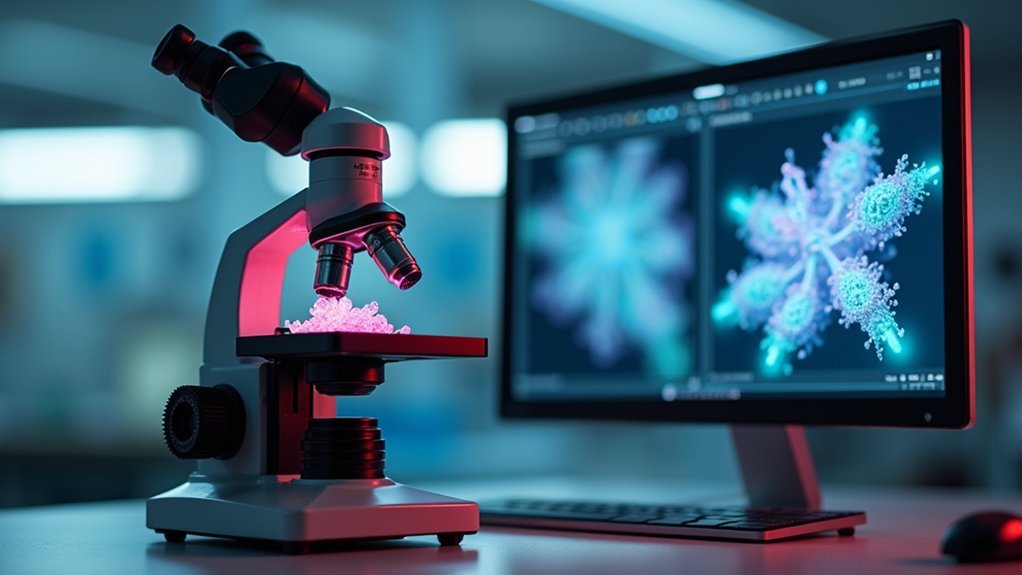
When selecting a microscope camera, you’ll need to guarantee compatibility with focus stacking software like Helicon Focus for successful integration and processing.
Your workflow efficiency will improve dramatically by choosing cameras that offer direct connectivity to automation tools such as Helicon Remote, which can control both your microscope and camera simultaneously.
The right software-camera combination will let you create automated capture sequences and organize your image stacks without manual intervention, saving you considerable time during complex microphotography projects.
Software-Camera Integration Essentials
The success of your focus stacking workflow depends heavily on how well your camera integrates with specialized software applications.
When using a microscope for detailed microphotography, seamless communication between hardware and software becomes essential.
Helicon Remote offers excellent control over camera settings while automatically transferring images to Helicon Focus for processing. The Pro version supports RAW formats and provides hardware acceleration for faster stacking of large image sets.
- Confirm your camera model is fully compatible with your chosen stacking software
- Check USB or Wi-Fi connection stability for reliable focus adjustments
- Look for software that automates the capture sequence for consistent results
- Verify RAW format support if you require maximum image quality
- Consider software that offers real-time preview of focus stacking results
Automation Workflow Options
Beyond basic camera-software integration, establishing a robust automation workflow can transform your focus stacking experience from tedious to effortless. Programs like Helicon Remote integrate directly with Helicon Focus, creating a seamless pipeline from image capture to final stack processing.
When setting up your automation workflows, consider connecting your camera to your microscope using a T-adapter for precise focus adjustments. This hardware compatibility is essential for software to control focus increments accurately.
For advanced users, Darktable’s LUA scripting capabilities offer customizable automation options for image acquisition. Look for software that supports batch processing to handle multiple image stacks simultaneously. You’ll save significant time during post-processing.
Remember that successful automation workflows for focus stacking depend on ensuring compatibility between your camera, microscope, and software components.
Camera Connection Options: USB, HDMI, and Wireless Solutions
Modern microscope cameras offer various connection methods that greatly impact your focus stacking workflow.
You’ll find direct USB and HDMI connections provide reliable performance and minimal latency, while wireless solutions offer flexibility at the potential cost of transfer speeds.
When selecting your setup, consider how adapters might solve compatibility challenges between your camera and computer, but be aware they can sometimes introduce unexpected issues with device recognition or signal degradation.
Direct Connection Advantages
When selecting a microscope camera for focus stacking, understanding connection options substantially impacts your workflow efficiency and image processing capabilities.
Direct connection advantages primarily revolve around reliability and control. USB connections provide immediate access to your camera’s full functionality, eliminating potential signal loss while enabling sophisticated software control for precise focus stacking parameters.
- USB connections offer consistent data transfer speeds ideal for high-resolution image capture
- HDMI outputs deliver real-time viewing on larger screens during critical focus adjustments
- Direct connections minimize latency—crucial when capturing multiple images for stacking
- Wired setups provide stable power supply, preventing interruptions during extended sessions
- Physical connections typically require less technical configuration than wireless alternatives
While wireless solutions offer mobility, direct connections remain the gold standard for professional focus stacking where precision and reliability are paramount.
Wireless Interface Performance
Although wireless interfaces offer unprecedented flexibility for microscope camera setups, they present distinct performance considerations for focus stacking applications.
When evaluating wireless solutions, you’ll notice they typically deliver lower frame rates and slightly higher latency compared to direct USB connections.
While you can control your camera remotely via Wi-Fi or Bluetooth—ideal for vibration-sensitive setups—these connections may introduce stability issues during critical focus adjustments.
Many professionals opt for dual-connectivity cameras that let you switch between wireless mode for convenience and USB for critical capture sessions.
If real-time adjustments are central to your workflow, consider how wireless performance might impact your precision.
Wireless interfaces excel in confined spaces or when you need to position your monitoring screen independently from your microscope—a valuable option despite the performance trade-offs.
Adapters and Compatibility Issues
Selecting the right adapter for your microscope camera represents one of the most critical yet overlooked aspects of creating successful focus stacks.
You’ll need to verify proper compatibility between your camera and microscope to achieve ideal results. T-adapters and C-mounts vary between manufacturers, directly affecting image alignment and focus quality.
When choosing your connection type, consider these options:
- USB connections offer direct computer integration, perfect for immediate image processing
- HDMI outputs enable real-time team analysis on larger screens
- Wireless solutions eliminate cable clutter and provide flexible positioning
- Built-in software compatibility can simplify workflow across different devices
- Adapter-specific requirements may limit camera choices with certain microscope models
Don’t assume universal compatibility—check specifications before purchasing to avoid frustrating alignment issues that can ruin your focus stacking efforts.
Budget-Friendly Microscope Cameras That Deliver Quality Results
Three excellent budget-friendly microscope cameras stand out for focus stacking applications without breaking the bank.
The AmScope SM-1TSZZ-144S-10M offers a broad 3.5x-180x magnification range, perfect for capturing detailed photos using its high-quality imaging system to enhance depth of field through stacking.
For portability, consider the TAGARNO ZIP with its impressive 1080p resolution at high frame rates—no software required for operation.
Meanwhile, the compact Olympus TG-6 surprises with its dedicated microscope mode that markedly improves macro photography capabilities.
Complement your setup with Helicon Focus software, which works seamlessly with these budget options to create impressive stacked images.
Don’t forget that affordable accessories like LED illuminators and diffusers can dramatically improve your results in challenging lighting conditions.
Advanced Camera Solutions for Professional Microphotography
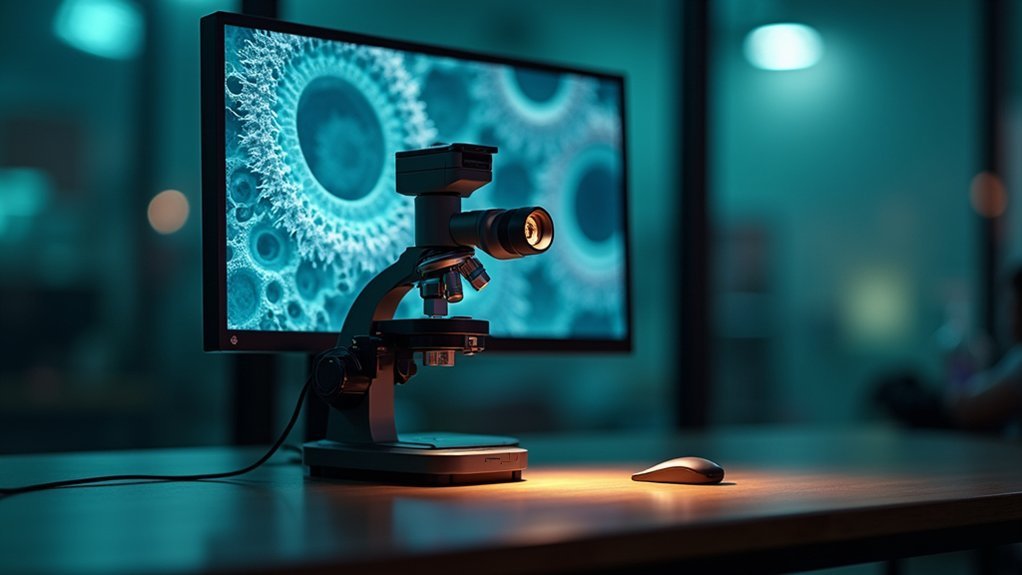
Professional microphotographers who demand exceptional image clarity will find high-end camera solutions offer substantial advantages over budget alternatives.
Systems like the TAGARNO PRESTIGE with 660x magnification integrate sophisticated software specifically designed for focus stacking workflows.
The most advanced camera solutions feature:
- High-resolution sensors that capture microscopic details with stunning precision
- Dedicated software for seamless focus stacking and image processing
- Manual focus adjustments with precise control for optimal focal depth
- Live view capabilities for real-time specimen assessment
- Compatibility with Plan Achromatic lenses for superior edge focus and color correction
When paired with specialty software like Helicon Focus, these cameras allow you to combine multiple images at varying focal depths, dramatically enhancing depth of field in your microphotography projects.
The result: remarkably detailed images that reveal structures invisible to standard imaging equipment.
Real-World Performance: User Reviews of Popular Microscope Cameras
TAGARNO TREND users consistently praise its intuitive interface and impressive 330x magnification with 1080p resolution, making it a standout choice for detailed focus stacking projects.
You’ll find that many photographers switch to this system after struggling with the Olympus TG-6, which despite its popularity, falls short in microscope mode, particularly when attempting full zoom clarity.
While the TAGARNO excels in most applications, some users still report occasional challenges when attempting complex focus stacking of highly textured specimens, though these issues are often resolved through proper technique and complementary software like Helicon Focus.
TAGARNO Users Speak
When investing in high-quality imaging equipment, real-world user experiences often provide the most valuable insights. TAGARNO camera users consistently praise these devices for their exceptional focus stacking capabilities and user-friendly interfaces.
TAGARNO TREND stands out for professionals using magnifications beyond 330x, allowing you to change the focus while maintaining clarity. The ZIP model earns accolades for its simplicity and high frame rates without extensive setup adjustments.
MOVE users highlight its separate processing unit for sharper imaging.
ZAP’s built-in laser pointer enhances precision, though additional lighting is sometimes needed.
Digital outputs considerably improve team collaboration.
TREND excels at focus stacking for detailed analysis.
Many users report improved documentation capabilities with TAGARNO systems.
These firsthand accounts confirm TAGARNO’s reputation for delivering professional-grade microscope cameras that simplify complex imaging tasks.
Focus Stacking Struggles
Despite the impressive specifications that manufacturers advertise, real-world users often encounter significant challenges when attempting focus stacking with microscope cameras.
You’ll likely face autofocus difficulties in low-contrast scenarios, particularly with models like the Olympus TG-6, where the system struggles to find clear focal points.
Many experienced photographers recommend you manually adjust the focus for static subjects, especially at higher magnifications where automatic systems frequently falter. Proper lighting becomes essential—consider adding diffusers or LED illuminators to enhance contrast and improve focus accuracy.
Camera stability can’t be overstated; even minor vibrations can ruin your focus stacking attempts.
Models like the TG-5 and TG-6 have been noted for clarity issues at full zoom, requiring additional technical adjustments to achieve the crystal-clear results you’re seeking.
Setting Up Your Camera and Microscope for Optimal Focus Stacking Results
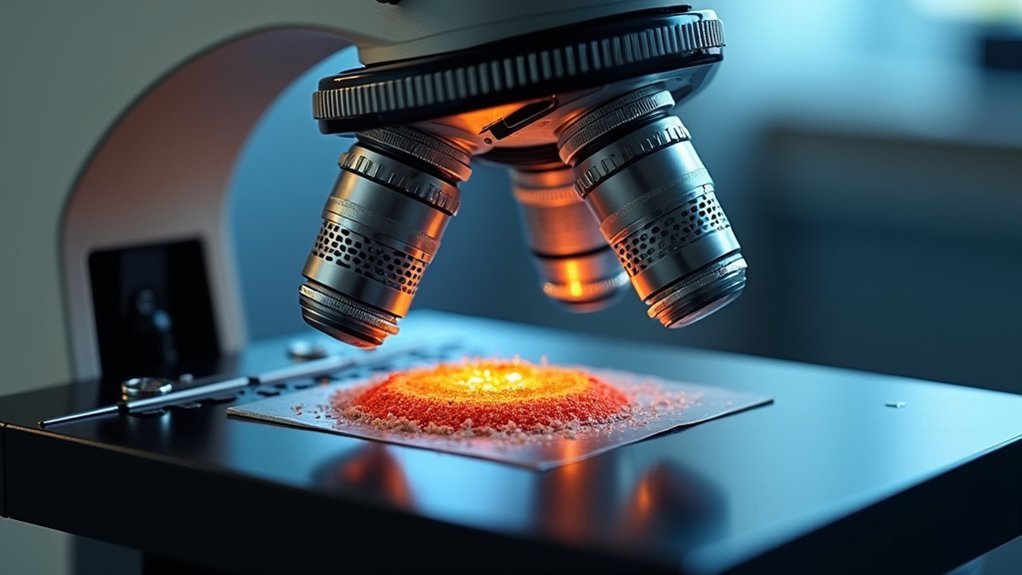
Achieving exceptional focus stacks begins with proper equipment configuration before you capture a single frame. Your microscope must feature a trinocular design that accommodates a camera while maintaining perfect alignment.
When shooting photos at highest magnification, stability becomes critical—even minor vibrations can ruin your entire stack.
For ideal results:
- Use a trinocular microscope for proper camera attachment and alignment
- Capture 15-35 images at different focus points for thorough stacking
- Employ specialized software like Zerene Stacker or Helicon Focus for processing
- Set up LED illuminators with diffusers to eliminate harsh shadows
- Secure both microscope and camera firmly to prevent movement during the capture sequence
Proper lighting greatly improves your final image quality, especially when working with specimens requiring nuanced detail preservation.
Frequently Asked Questions
What Cameras Do in Camera Focus Stacking?
In camera focus stacking, your camera captures multiple images at different focal points. It’ll then automatically combine these shots to create one perfectly focused image with extended depth of field throughout the entire subject.
How Do You Get a Clearer Image on a Microscope?
You’ll get clearer microscope images by properly aligning optical components, using appropriate lighting techniques, adjusting focus manually, implementing focus stacking for greater depth, and selecting high-quality lenses like Plan Achromatic types for edge-to-edge sharpness.
How Do I Choose a Microscope Camera?
When choosing a microscope camera, you’ll need to match resolution to your magnification needs, guarantee compatibility with your microscope type, consider frame rate for live samples, and evaluate additional features against your budget.
How Many Megapixels Is Good for a Microscope Camera?
For a microscope camera, you’ll want at least 5-10 megapixels for good detail without noise. If you’re doing focus stacking, aim for 12-20 megapixels to allow for cropping while maintaining quality.
In Summary
Choosing the right microscope camera is essential for your focus stacking success. You’ll want to balance resolution, sensor quality, and software compatibility with your budget. Whether you’re a hobbyist or professional, there’s a solution that fits your needs. Remember to properly set up your equipment and practice your technique—soon you’ll be capturing stunning, crystal-clear micro images with incredible depth and detail.

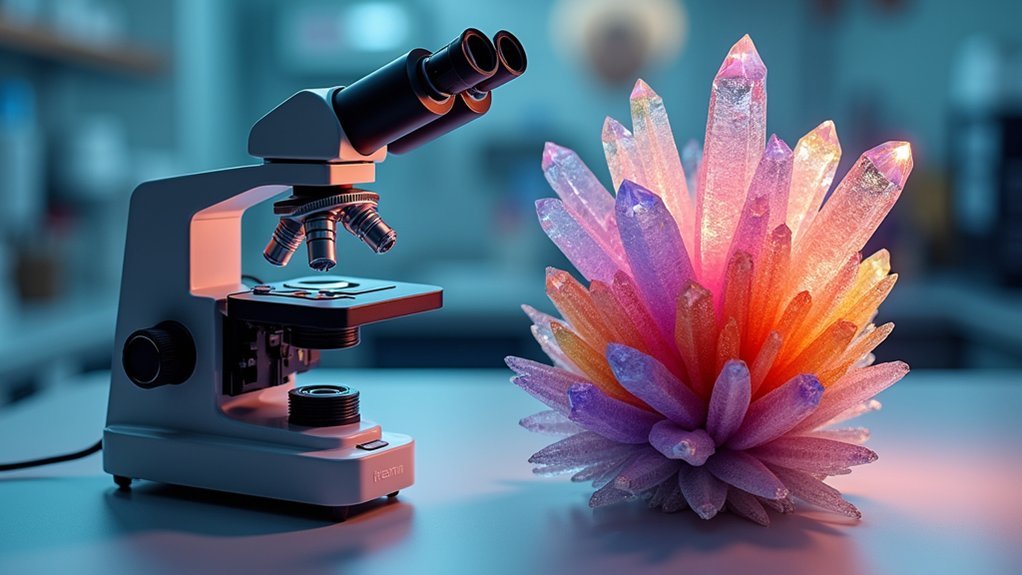



Leave a Reply